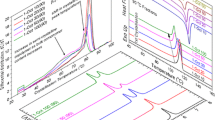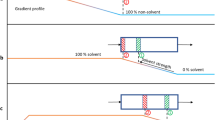Abstract
THE gradient elution method for polymer fractionation was introduced by Williams1–3. To fractionate larger amounts of polymer, a scaled-up apparatus was necessary. Previous experience in column design in this laboratory advised against an increase in the dimensions of a single column to avoid difficulties in temperature control and channelling. Consequently, an apparatus was built with six parallel columns, each 1 m. in length and 2.5 cm. in inside diameter. A sketch of the multicolumn unit is shown in Fig. 1. The upper ends of the aluminium columns are welded to the bottom of a common solvent-mixing container. The metal container is 7 litres in capacity and is fitted with a heater, regulator, stirrer, and sight glass. The solvent mixture is heated to the proper temperature for the desired column temperature gradient. The lower ends of the columns are connected to a common outlet and immersed in a water thermostat. The temperature gradient along the insulated columns is found to be nearly linear, as measured by four evenly spaced thermocouples. The apparatus is charged and operated similarly to single columns previously described1–3. Two ganged ‘Minipumps’ (Milton Roy Company, Philadelphia, Pennsylvania), each with an adjustable 12–120 ml./hr. pumping capacity, regulate the rate of withdrawal of polymer solution from the common outlet. The pumps also replenish the solvent at the head of the column at the same rate, thus establishing the solvent gradient and degree of fractionation. The evaporation of the solvent for recovery of fractions is done automatically, in situ, using a rotary vacuum evaporator, fitted with a nitrogen inlet, vacuum line, and water-bath. A low evaporation temperature coupled with the nitrogen ensures polymer stability.
Similar content being viewed by others
References
Williams, R. J. P., Analyst, 77, 905 (1952).
Bannister, D. W., Phillips, C. S. G., and Williams, R. J. P., Anal. Chem., 26, 1451 (1954).
Baker, C. A., and Williams, R. J. P., J. Chem. Soc., 2352 (1956).
Fox, T. G., and Flory, P. J., J. Phys. and Coll. Chem., 55, 221 (1951).
Author information
Authors and Affiliations
Rights and permissions
About this article
Cite this article
CANTOW, M., PORTER, R. & JOHNSON, J. Large-Scale Polymer Column Fractionation. Nature 192, 752–753 (1961). https://doi.org/10.1038/192752a0
Issue Date:
DOI: https://doi.org/10.1038/192752a0
- Springer Nature Limited
This article is cited by
-
Fraktionierung von Polymeren
Kolloid-Zeitschrift und Zeitschrift für Polymere (1968)





